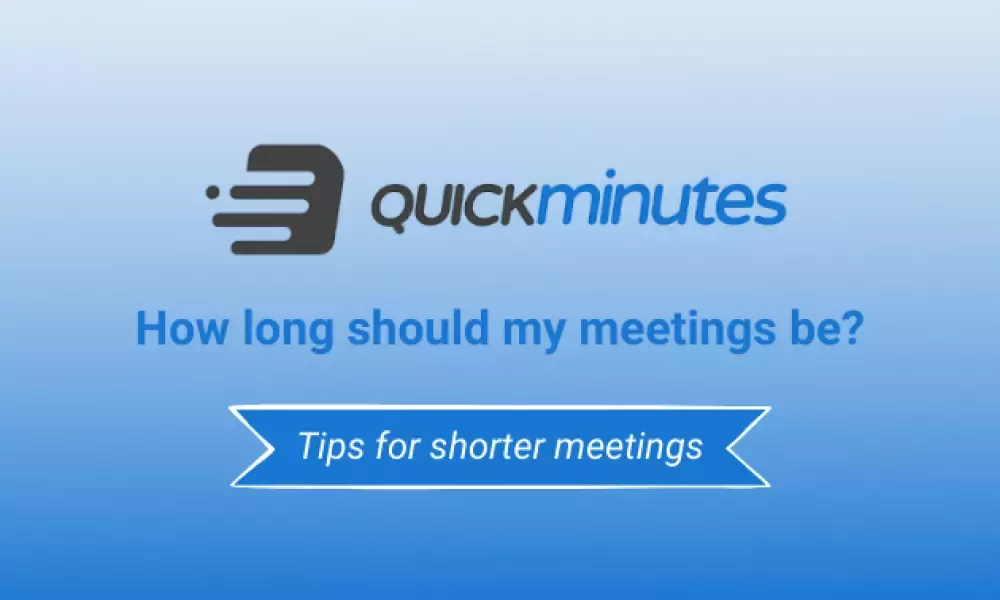
How long should my meetings be?
How to keep your meetings short and to the point
Welcome back! If you have been following our blog posts thus far, you will have read in our previous articles the QuickMinutes tips & tricks to bring high performance meetings to your organisation. Today, we will look in detail at a question the QuickMinutes team is often asked “How long should my meetings be?”
Why is it so important you understand how long your meetings should be? Well, firstly they are expensive. Secondly, according to many experts, our attention spans have been decreasing over the years (there is a high probability almost half of you will not reach the end of this blog.)
According to research carried out by ReadyTalk the average cost of a meeting is $338 (imagine the cost when the CEO and business leaders meet for one hour.) In America, workers hold approximately 11 million meetings per day (220 million meetings per year.) On average, they found employees attend 62 meetings per month ($338 x $62 = $20,956 montly.) Now, do you agree on the importance of understanding how long your meetings should be? Here are some tips to make sure your time and money are being spent on a valuable meeting.
When scheduling a meeting, the organiser should be able to estimate how long it will take based on the agenda. Calendar invitations usually allocate an hour. Since your meeting requires the valuable time and participation of multiple people within your organisation, it is important to decide the duration of the meeting beforehand, so that it does not end up wasting people's time.
As you probably know from experience, shorter meetings are often more effective than longer meetings because attendees lose interest after a certain period of time. Longer meetings often turn into boring discussions that stray off topic and do not lead to any results. In a shorter meeting, it is easier to keep up high levels of engagement and people maintain their interest. Shorter, better & more efficient meetings will save your organisation’s time & money.
Setting the correct amount of time is crucial to leading a successful meeting. Shortening the time allocated can lead to people acknowledging the shorter meet slot and participants often become more efficient. Team members that have scheduled back-to-back meetings need to get to their next call on time. As a result, they will stick to the allocated time per item on the agenda and people generally do not stray off topic.
It is most common to see organisers book a meeting slot for 30 minutes or 60 minutes. Shortening these to 20 minutes & 50 minutes will bring a sense of urgency and increase productivity. Secondly, a well prepared agenda distributed in advance would have you surprised at what can be achieved in just 20 minutes. These 20 minute recaps should be used for project updates and sales updates which still allow adequate time to answer any project-related queries. Similarly, scale your 60 minutes meeting slots back to 50 minutes. 50 minute meetings are for in-depth conversations like a monthly or quarterly review. This allows time to recap & set milestones to be completed before the next deadline. These 50 minute slots can also be used for more complex projects in your organisation.
It is not recommended that your team meet for over an hour, but it is inevitably going to happen for some more serious issues such as compliance or legal issues or annual strategic planning meetings. Here are a number of tips for keeping your meetings shorter;
- Allocate the meeting slot time beforehand.
- Prepare and share an agenda well in advance of meeting (including time slots per item). This allows people to prepare properly and it will also increase engagement.
- Record meeting minutes / notes, this ensures accountability and allows you to start your next agenda with a brief recap of your last meeting.
- Follow up. Follow up is key to the success of any meeting. Make sure you follow up on decisions made so you reach your organizational goals.
These four steps will help you run a more productive and effective meeting.
Benefits of QuickMinutes meeting software:
Create virtually any type of meeting in seconds with your daily conferencing tool and notify your colleagues instantly. It’s so intuitive you will feel like you have been using QuickMinutes for ages.
Use our Agenda Builder to keep you on track. Create the agenda for your meeting using agenda builder with topics & subtopics, and assign time and purpose.
Use our Minute Builder to streamline everyone on the team. Take notes using the minutes builder during or after the meeting to summarize the discussion and corresponding actions.
Use our calendar integration, ensure you don’t miss any meetings. Synch and view your meetings with a built-in calendar or third-party calendar of your choice, so you stay organized.
We provide meeting collaboration. Drive paperless meetings. Easily share meetings, agenda, and minutes with your colleagues to review, update, and download.
Tracking attendees has always been a challenge. Mark attendance for a meeting instantly and proceed accordingly using the QuickMinutes platform, a central hub for all your team meetings. You can search for meetings, view what happened in that meeting, and download resources as per your requirements. Use QuickMinutes.com to track and analyze the meetings happening in your organization, including participation, frequency, and agendas.
Are you interested to see it in action?
See for yourself with our free startup package:
https://quickminutes.com/register
The importance of effective meeting management Meeting Performance